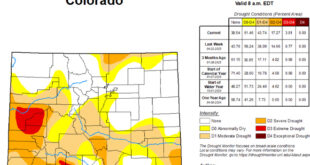“We have to decide what’s best for the district”
The effects of several years of razor-thin budget margins are creeping in on Gunnison Watershed School District classrooms, with just enough money to provide the minimum staffing at the first-grade level next year.
A group of Gunnison Elementary School first-grade teachers and the parent of a first grader appealed to the school board on Monday, June 3, after contract negotiations had ended, for the reinstatement of a teaching position they’ll lose in the coming year, and for smaller class sizes to better serve the district’s six- and seven-year-old students.
Instead of a state requirement or the board policy that used to guide the size of classes, the district has adopted a guideline of 15 to 19 students for kindergarten classes, 19 to 23 students for first through third grades, and classes of 20 to 25 students in fourth grade classes on up.
If nothing changes before next year, Crested Butte Community School will split 43 incoming first graders into two classes, and Gunnison Elementary School will divide 81 students into four groups, landing squarely inside the guidelines.
If the board adheres to the guidelines, Crested Butte would need just a few more first-grade students to max out the class sizes, and GES would need more than 11 students to push them past the threshold.
That, the teachers said, is out of line with the standards of other states and is inconsistent with the needs of the kids, who will be asked to share one teacher’s time with 20 other students who have a range of needs and abilities. Next year there could be as many as nine first graders at GES with special needs, the teachers said.
“Our intentions here are twofold. First, we would like an additional section added to first grade for the upcoming school year,” teacher Liz Hicks told the board. “Secondly, we would like to propose a revision to board policy related to class sizes and aligning kindergarten and first grade.”
Hicks said there was a correlation between class size and student achievement that made increasing class sizes a danger to ignore. “In order for long-term achievement to occur, research indicates that small [student-to-teacher] ratios need to be consistent from grade to grade,” Hicks said.
Board member Bill Powell asked to see the research and commented on the prominence of the research the teachers cited, which was from Project STAR (Student-Teacher Achievement Ratio), a four year study of Tennessee school children that showed “smaller classes did produce substantial improvement in early learning and cognitive studies.”
Currently CBCS kindergarteners will go from classes of 14 students to classes of 21 or 22, while GES students will see a similar increase in class size.
“I think this district has invested a lot of money over the years and been ahead of the curve with programs for three-year-olds and four-year-olds and kindergarten,” Powell said, explaining the uncertainty of the district’s financial future. “And there’s no way, as board treasurer, that I could continue to support reducing our fund balance. We’re being pretty conservative right now and it’s hard to balance what moms want and what dads want, what teachers want and what we all want for the children. We have to decide what’s best for the district.”
When the district was faced with almost 90 first graders at GES last year, they got a barrage of calls from parents concerned about the large classes. At the last-minute the district hired a fifth teacher to ease the strain.
That teaching position came at the cost of a new school bus for the district and after just one school year, with fewer students projected, the district’s Administrative Council and the school board opted to cut that position. And the projected class size isn’t much smaller than it was a year ago at this time, GES principal Sally Hensley said.
“I have a first grader and I got a little nervous when I heard class sizes could be as large as 23,” first-grade parent Annie Yoder told the board. “I think this year you did a great job of saying ‘This isn’t going to work for our community, this isn’t going to work for our teachers or our students.’ Choosing that fifth teacher was an excellent decision and I thank you for that.”
She urged the board to be proactive in finding room in the budget for the additional teacher to avoid another year of fielding phone calls and questions from parents wondering why their child’s class got so big.
“That to me is concerning because I want my child watched out for just like every parent does,” Yoder said.
Hensley’s own concern is tempered by her knowledge that the school board will undoubtedly support the students and make the right call if it becomes necessary to increase the number of first-grade classes next year.
“Always, I know that the school board will make decisions with the kids as their highest priority,” she said.
The board said they would have a better enrollment estimate in August, but urged the teachers to continue their engagement in the process. No date was set for a decision.
 The Crested Butte News Serving the Gunnison Valley since 1999
The Crested Butte News Serving the Gunnison Valley since 1999


